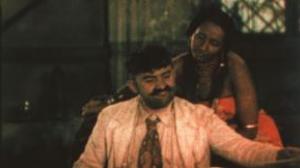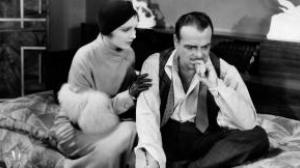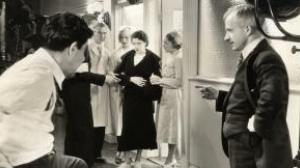DOWN AND DIRTY IN GOWER GULCH: POVERTY ROW FILMS PRESERVED BY UCLA

THE SIN OF NORA MORAN
During the 1930s and 1940s, while the major studios controlled first run theatres, numerous independent studios produced what were called “B-Films,” whether westerns, crime dramas, or horror. Low budget studio independents, like Monogram, Producers Releasing Corporation, Reliance, Republic, and Tiffany, were housed in rental studios off Gower Street in Los Angeles, often referred to as “Gower Gulch.” So-called “Poverty Row” pictures were usually made for $100,000 or less, and shot on five to ten day shooting schedules. Despite their exceedingly low budgets, resulting in often cheesy sets and under par acting, the poverty row studios had a surprising degree of freedom to tackle controversial subject matter, whether venereal disease, the psychology of kidnap victims or rampant quackery in the medical profession. The lack of budget also gave creative film directors, like Edgar G. Ulmer and Lowell Sherman, the opportunity to turn minimal resources into expressive devices. UCLA Film & Television Archive has moved increasingly towards preserving independent and poverty row titles, many of which are no longer copyrighted, because their producers never registered the films to begin with or lost rights because they went bankrupt. These “orphan films” visualize many of the repressed or forbidden themes that preoccupy the nether regions of the American psyche. Get ready for a wild ride! (Jan-Christopher Horak, Director, UCLA Film & Television Archive).
- Wed., Jul. 3 | 7:00 PM4070 Vilas Hall

In 1913 German East Africa (now Tanzania), an impoverished countess is purchased to be the wife of an abusive and hated plantation owner (Hersholt), and she soon finds herself terrorized by the alien environment. Tiffany, a low-budget, independent studio, challenged the majors with this colonial melodrama, investing half a million dollars to make a talkie in two-color Technicolor. Although Mamba was a box-office hit, Tiffany went bankrupt in 1932 and many of the small studio’s releases disappeared into oblivion. This UCLA restoration was made possible in part by the discovery of a complete nitrate print discovered in Australia in 2009! Preceded by Hearst Metrotone News, Vol. 1, No. 269 (1930, 9 min.) and Me and the Boys (1929, 9 min.)
- Wed., Jul. 10 | 7:00 PM4070 Vilas Hall

The superstitious citizens of a small European village believe vampirism is to blame for the increasing discovery of corpses drained of blood. Meanwhile, the sinister Dr. von Niemann (Atwill) toils in his laboratory to sustain the life of the artificial being he has created (it looks suspiciously like a loofa sponge oxygenating in an aquarium). Goofy fun, UCLA's restoration of The Vampire Bat recreates the sensational Gustav Brock color sequence, unacknowledged and unseen since the movie’s first release. Preceded by Hearst Metrotone News, Vol. 4, No. 250 (1933, 9 min.) and Ub Iwerks’ animated Jack Frost (1934, 9 min.)
- Wed., Jul. 17 | 7:00 PM4070 Vilas Hall

Exiled from NYC, quack doctor Silas Benton (portrayed by director Sherman as an affectless sociopath) lands in Chicago, promoting himself to the idle rich and famous as the doyen of nip-and-tuck. Utterly indifferent to his trail of human wreckage, Benton dallies promiscuously with every woman in sight and gorges himself with riches gleaned from his outlaw surgeries. His ultimate comeuppance is designed to leave the picture audience cheering. Preceded by Hearst Metrotone News, Vol. 4, No. 226 (1932, 9 min.) and Betty Boop as Snow White (1933, 7 min.).
- Wed., Jul. 24 | 7:00 PM4070 Vilas Hall

A young shipping tycoon contracts an infectious disease and unknowingly transmits it to his wife. Sponsored by the Canadian Social Health Council, this feature about venereal disease was Ulmer's first American film as director after starting his career in Germany. Intended as sexual education, not exploitation, Damaged Lives concentrates optimistically on hope provided by knowledge and discretion. Preceded by Hearst Metrotone News, Vol. 4, No. 252 (1933, 9 min.) and the Fleischer Studios cartoon Dancing on the Moon (1935, 8 min.).
- Wed., Jul. 24 | 8:30 PM4070 Vilas Hall

The standard pre-Code plot of a victimized woman (The Mummy’s Johann, as Nora) who descends into a life of degradation is elevated through a series of flashbacks, flash-forwards and flashbacks-within-flashbacks. Filmed on an ultra-low budget, The Sin of Nora Moran’s storytelling style is so complex that the narrative assumes a free-form, dream-like quality that enhances rather than detracts from it. Haunting, hallucinatory, artistic, exploitive, -- this may be the best B-film of the 1930s. Preceded by Hearst Metrotone News, Vol. 4, No. 269 (1933, 9 min.) and Ub Iwerks’ Balloon Land (1935, 7 min.).
- Wed., Jul. 31 | 7:00 PM4070 Vilas Hall

After seeing his father die in a car accident, young Paul (Lydon) has a recurring dream in which a mysterious gentleman attempts to woo his mother. When he realizes his dream is coming true, Paul tries to stop the relationship, and eventually learns the truth about his dad’s death. Working with the slimmest of budgets, Ulmer steals admirably from Hamlet and adds a major dose of post World War II interest in Sigmund Freud. A brilliant exercise in style, Strange Illusion’s dream sequences are hardly differentiated from the rest of the film’s shadowy black-and-white chiaroscuro lighting, creating a sense of delirium throughout the story. Preceded by News of the Day, Vol. 17, No. 288 (1945, 8 min.) and Betty Boop in Grampy’s Indoor Outing (1936, 7 min.)
